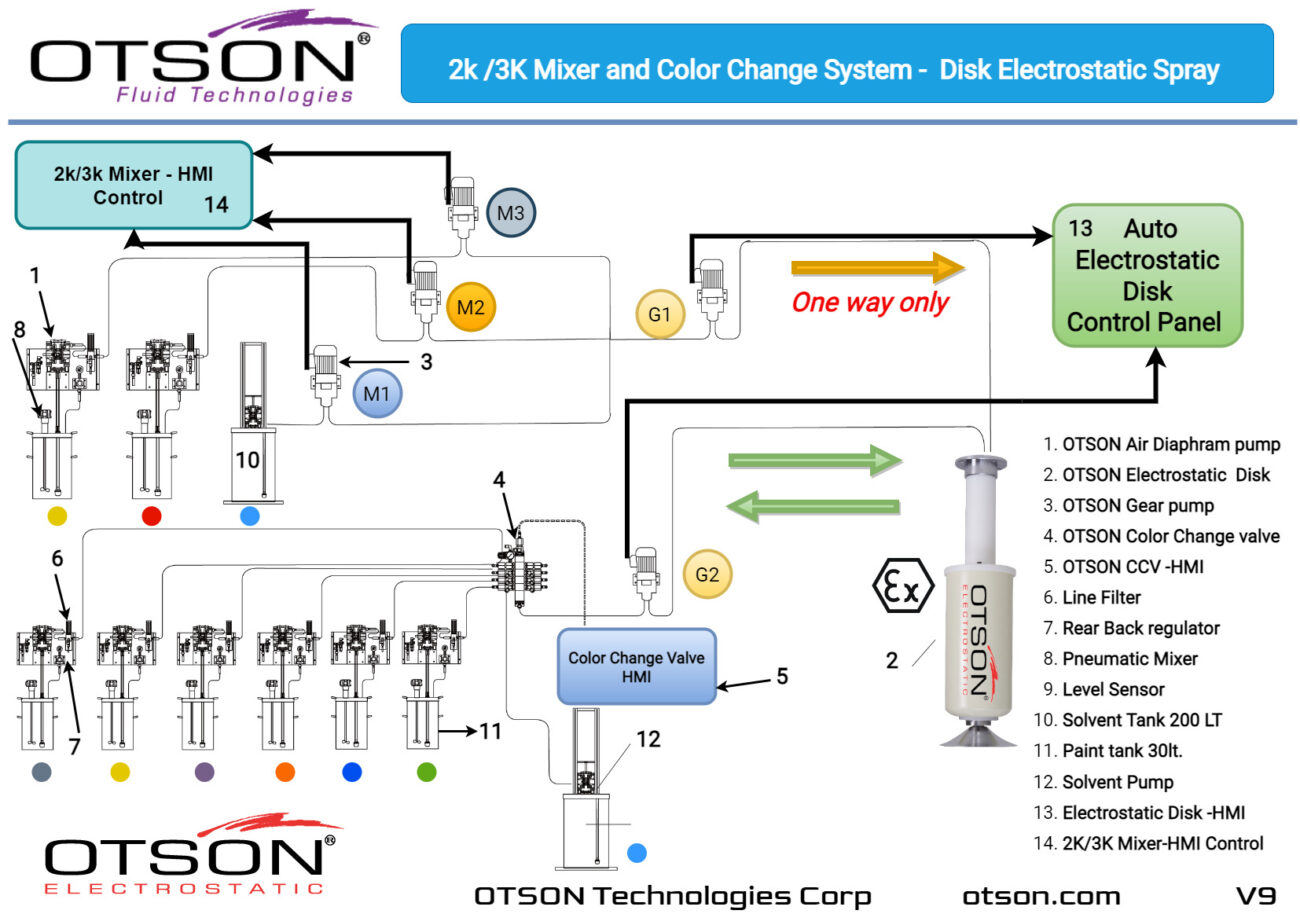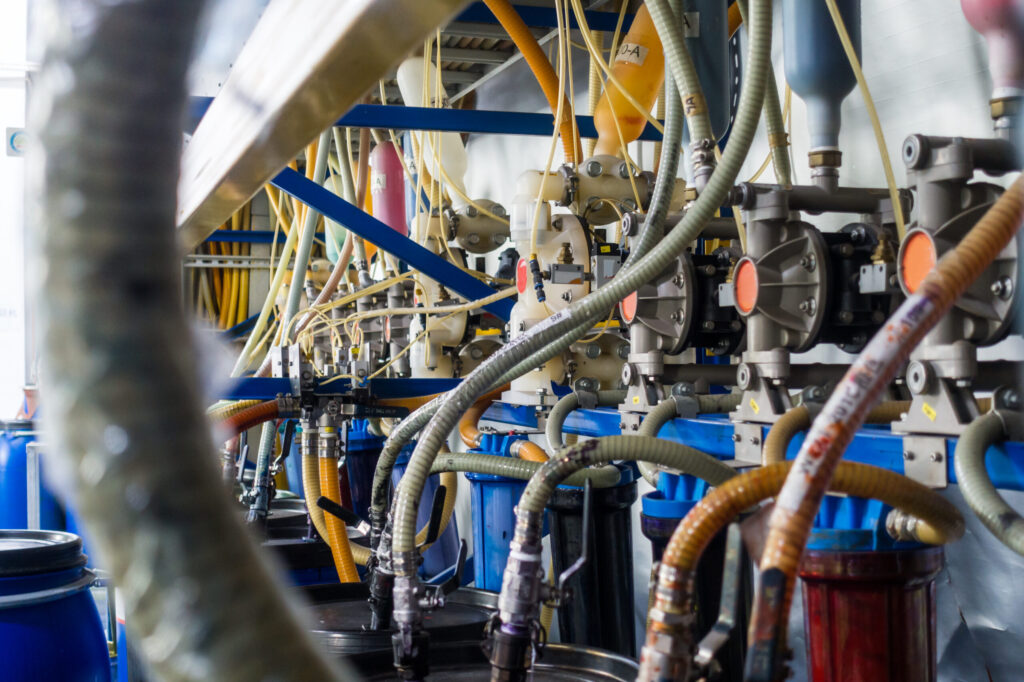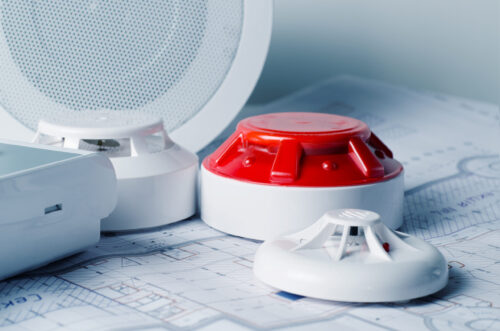Electrostatic spray coating has become increasingly popular in various industries due to its efficiency and high-quality results. However, the need to mix and change colors quickly and efficiently has always been a challenge for painters. Traditionally, this was done manually, which was time-consuming and resulted in a significant amount of waste. The 2K/3K mixer and auto color change system is designed to address these challenges and provide a more efficient and cost-effective solution.

The 2K-3K Electronic Mixing & Dosing System typically comprises of the following components:
- Metering Pumps: These pumps are used to accurately control the flow rate of each component, ensuring that the correct proportion is mixed and sprayed.
- Mixing Chamber: The mixing chamber is where the two or three liquid components are combined and mixed together.
- Control Unit: The control unit is the heart of the system and is responsible for monitoring and adjusting the flow rate of each component. It may use electronic sensors, computer control and software to manage the mixing and dosing process.
- Display Unit: A display unit is used to show the operator the current status of the system, including the flow rate of each component, total amount of liquid mixed and any alarms or faults that may arise.
The system may also be equipped with additional features such as automatic cleaning, continuous monitoring, and alarms for low level and low pressure, to ensure the reliable and consistent operation of the mixing and dosing process.
Overall, the 2K-3K Electronic Mixing & Dosing System provides precise control over the mixing and dosing of two or three liquid components, which results in a more efficient, consistent and uniform application of the sprayed liquid.
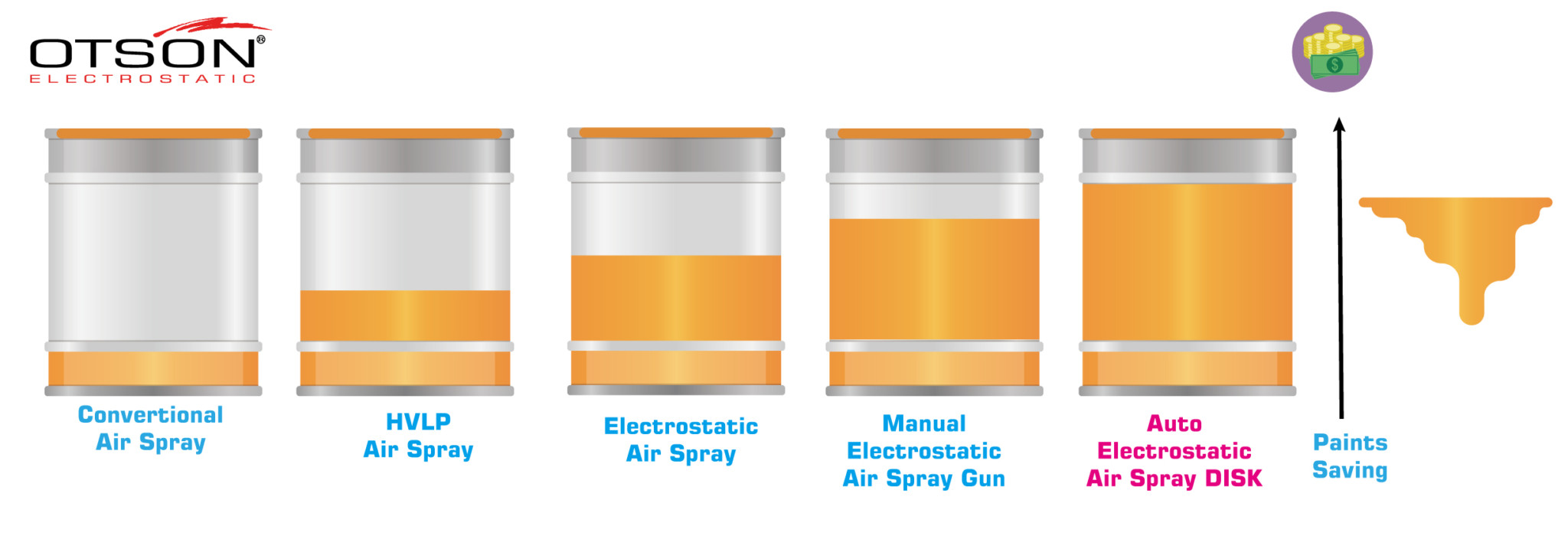
2K paint hardener is a curing agent that is used in 2-component (2K) paint systems to increase the curing speed and hardness of the paint. It is typically composed of polyisocyanates, which react with the paint’s polyol component to form a cross-linked polymer network. This network provides the paint film with its hardness, adhesion and chemical resistance properties.
When using 2K paint hardener, it is important to use the correct mixing equipment to ensure proper dispersion and mixing of the hardener into the paint. A high-shear mixer, such as a rotor-stator or a planetary mixer, is typically used for this purpose. These types of mixers create a high level of mechanical shearing that helps to break down any lumps or clumps in the hardener, and also promotes better dispersion of the hardener particles throughout the paint.
In addition to the mixer, it is also important to use proper measuring equipment, such as a graduated cylinder or a digital scale, to measure out the correct amount of hardener according to the manufacturer’s instructions. This is crucial to ensure the proper mixing ratio and to achieve the desired curing and hardness properties in the final paint film.
It is also important to use appropriate safety equipment, including gloves and a respirator, when handling 2K paint hardener, as it can release harmful vapor when exposed to high temperatures and humidity.
In summary, 2K paint hardener is an essential component in 2-component paint systems, and it is important to use the correct mixing and measuring equipment, as well as appropriate safety equipment, to ensure proper mixing, dispersion, and safe handling of the hardener.
3K paint refers to a 3-component (3K) paint system, which typically includes a base paint, a hardener, and a thinner or reducer.
The use of a 3K paint system is usually necessary when the paint is being used in industrial or automotive applications where a high level of chemical resistance, durability, and hardness are required. The addition of a thinner or reducer in a 3K paint system allows for better flow and atomization of the paint, resulting in a smoother, more consistent finish.
In automotive industry, the use of 3K paint system is common, it allows a better leveling of the paint and a better finish, also it allows to apply the paint in thicker layers, which is important for repair work, for example.
Another advantage of 3K paint is that it can be applied at higher temperatures and humidity than 2K paint, which makes it ideal for use in environments where these conditions are present.
Additionally, the use of a 3K paint system can also be necessary in certain industrial applications, such as marine and aerospace, where the paint must be able to withstand harsh environmental conditions, including exposure to chemicals, saltwater, and extreme temperatures.
In summary, 3K paint system is typically used in industrial and automotive applications where a high level of chemical resistance, durability, and hardness are required, also it allows a better leveling of the paint and a better finish and can be applied in thicker layers.

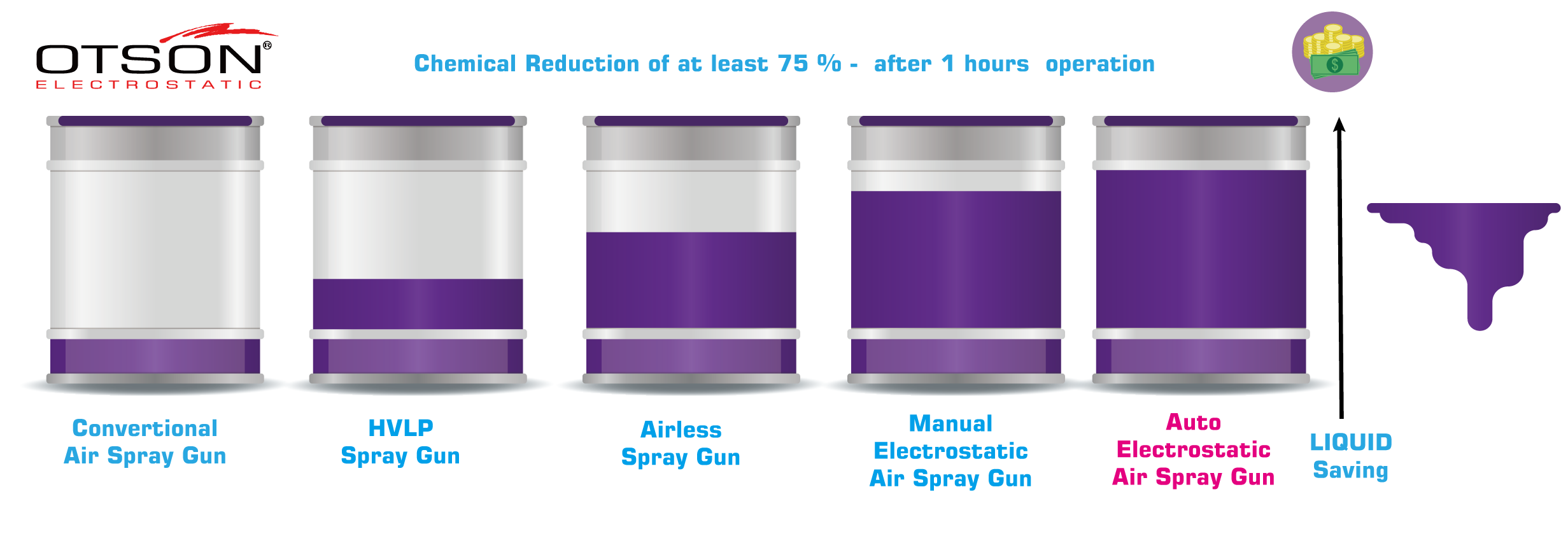
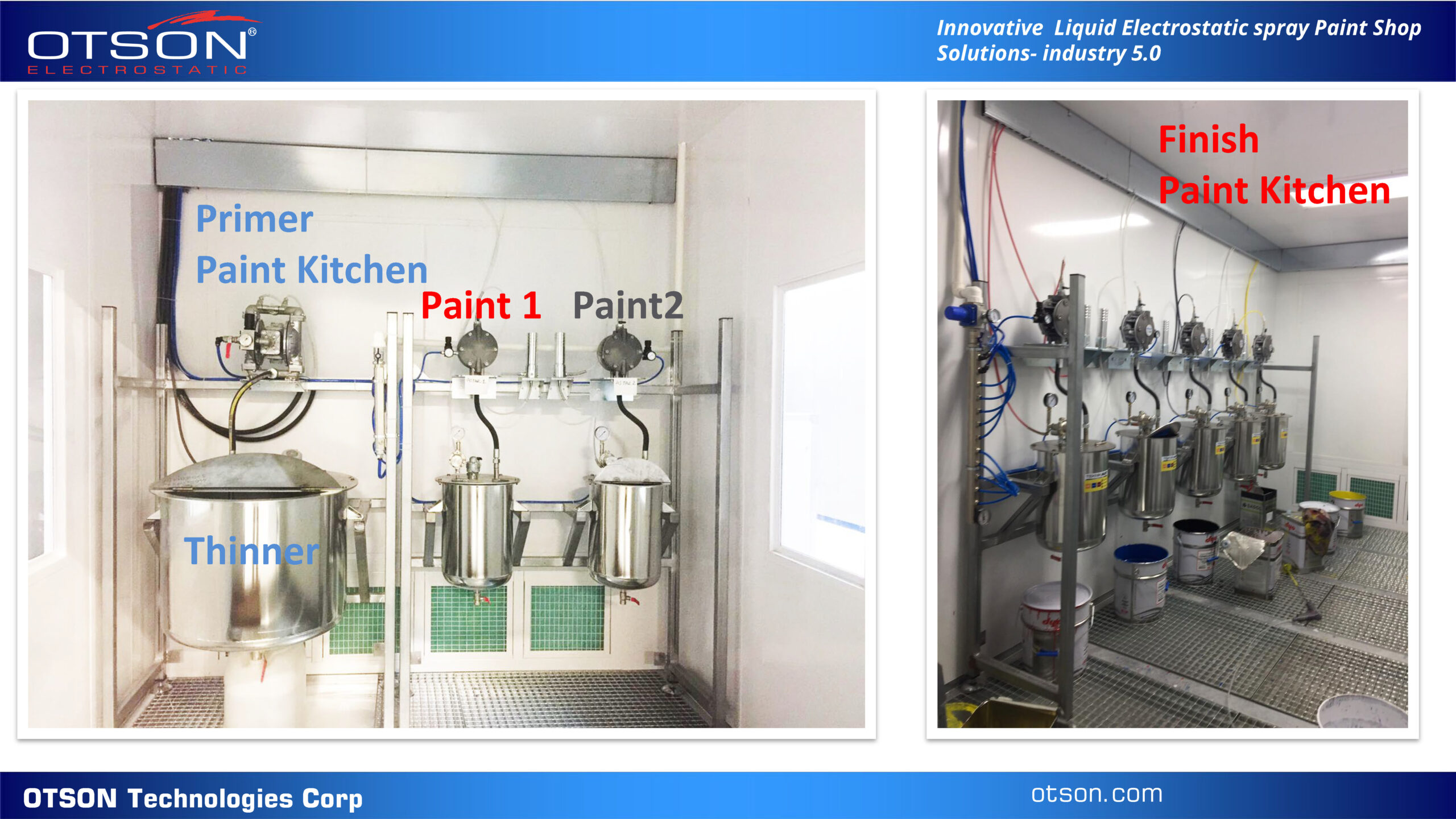
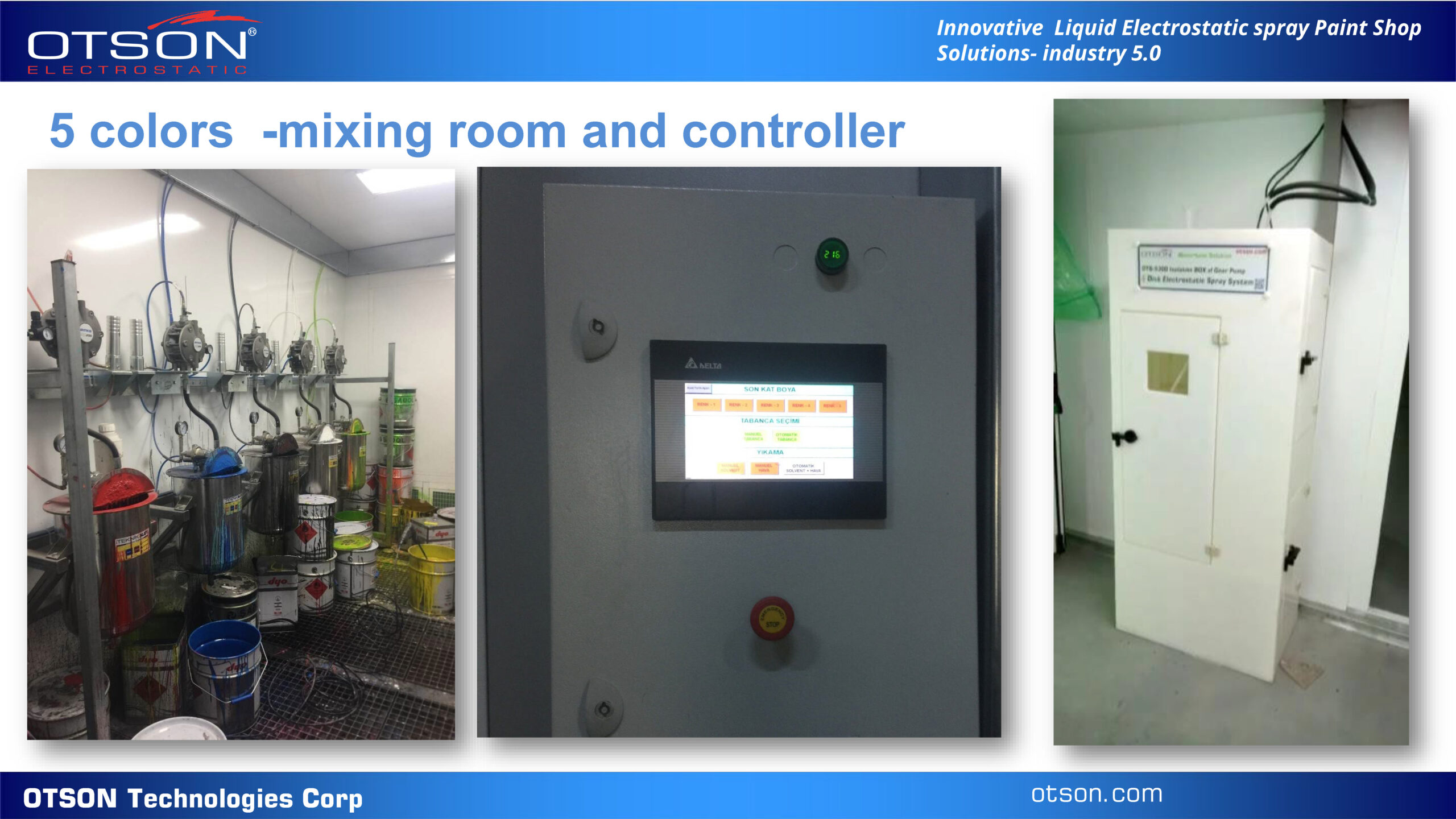
Here are a few additional details about mixer rooms in paint shop factories:
- Mixing equipment: The mixer room will typically contain a variety of mixing equipment, including mixers, agitators, and stirring devices. These may be batch mixers, continuous mixers, or other types of mixers depending on the needs of the factory. The mixing equipment is used to combine the various components of the paint, including pigments, solvents, and additives, to create the desired color and consistency.
- Storage tanks: The mixer room will usually have a number of storage tanks for storing the mixed paint until it is needed. These tanks may be made of a variety of materials, including stainless steel, polyethylene, or fiberglass, depending on the type of paint being stored. The tanks may be equipped with agitators or stirrers to keep the paint well-mixed, and they may also have level sensors and other monitoring equipment to ensure that the paint is being stored properly.
- Pumps and hoses: The mixer room will typically have a variety of pumps and hoses to transfer the paint from the storage tanks to the painting area. These may include air-powered double diaphragm pumps, centrifugal pumps, or other types of pumps depending on the needs of the factory. The hoses used to transfer the paint may be made of a variety of materials, including rubber, PVC, or polyurethane, and they may be equipped with fittings and other components to ensure that the paint is delivered smoothly and consistently.
- Safety equipment: The mixer room should be equipped with appropriate safety equipment to protect the workers who are preparing the paint. This may include gloves, masks, respirators, and other personal protective equipment, as well as emergency showers and eye wash stations. It is important to follow all safety guidelines and procedures when working in the mixer room to ensure the safety of all personnel.
The Auto Color Change System is a technical solution for liquid electrostatic spray equipment, such as auto electrostatic spray bell, auto electrostatic spray disc, and auto electrostatic spray gun. This system is designed to provide rapid and accurate color changes for spray equipment in industrial applications, including automotive, aerospace, and other manufacturing processes.
The Auto Color Change System utilizes a series of valves and pumps to control the flow of paint and the color change process. The system is fully automated, reducing the need for manual intervention and streamlining the painting process. This makes it possible to change colors quickly and accurately, resulting in improved productivity and reduced waste.
Here are some of the key features of the Auto Color Change System:
- Fast and Accurate Color Changes: The system is designed for rapid and accurate color changes, allowing for improved productivity and reduced downtime.
- Fully Automated: The Auto Color Change System is fully automated, minimizing the need for manual intervention and streamlining the painting process.
- Versatile: The system is compatible with a wide range of paint types, including solvent-based and water-based paints, making it adaptable to various industrial applications.
- Programmable: The user-friendly interface and controls make it easy to program and operate, allowing for quick and seamless color changes.
- High-Quality Finishes: The Auto Color Change System enables the application of a consistent and high-quality finish, improving the overall quality of the paint job.
- Customizable: The system can be customized to handle a range of color changes, from two to twenty or more, depending on the specific needs of the application.
- Efficient: The system reduces waste and cleanup time, making it an efficient solution for industrial painting processes.
- Reliable: The Auto Color Change System is designed to be reliable and long-lasting, ensuring consistent performance over time.
In conclusion, the Auto Color Change System for liquid electrostatic spray equipment provides a technical solution for efficient and accurate color changes. It is an essential component of industrial painting processes, providing high-quality finishes and improving productivity while reducing waste. The system is versatile, compatible with a range of paint types, and can be customized to meet the specific needs of any industrial application. With its fully automated and programmable features, the Auto Color Change System offers a reliable and efficient solution for liquid electrostatic spray equipment.
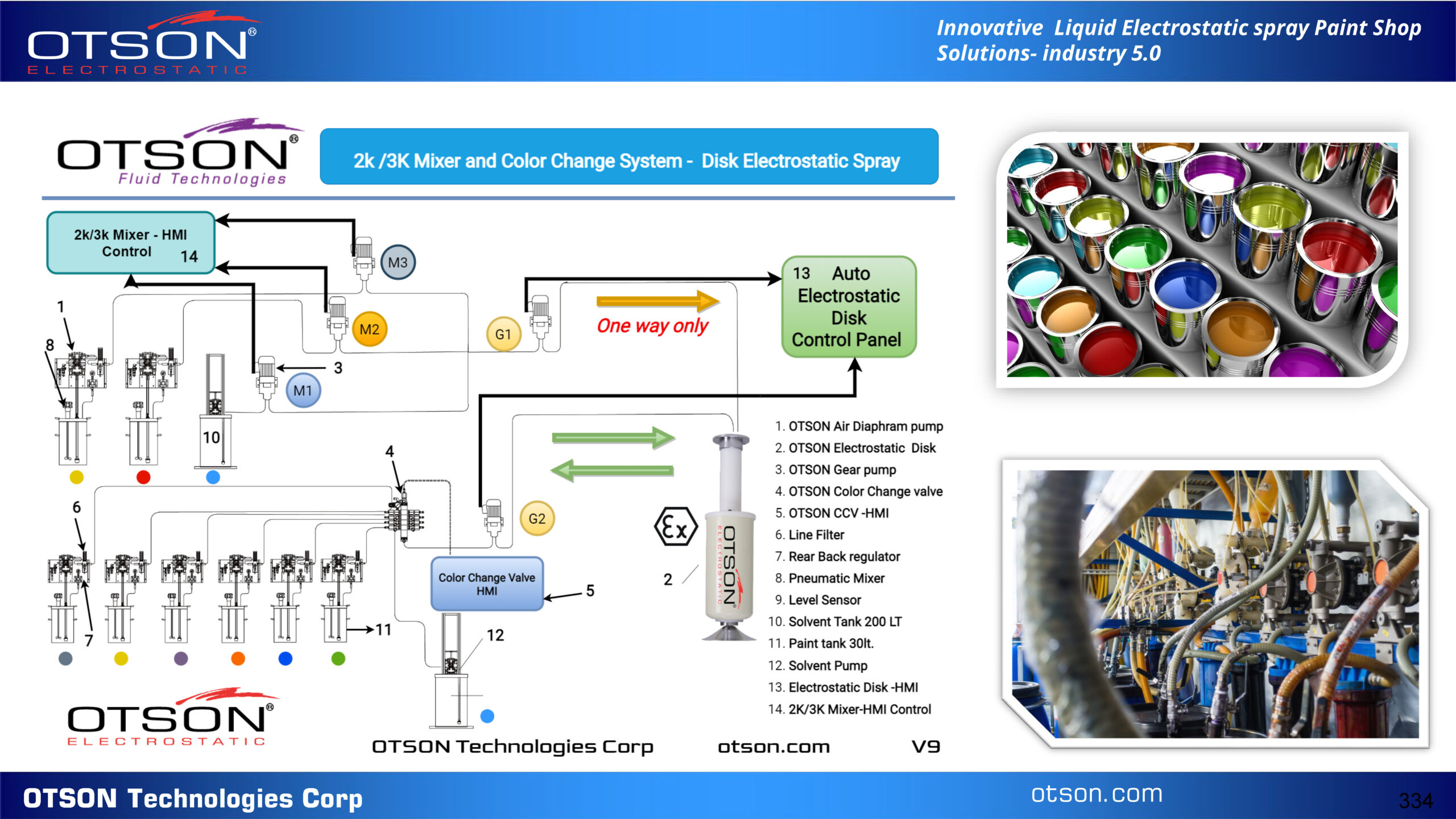
Color change valves, also known as paint dispensers, are a valuable investment for any business in the painting industry. These devices are used in paint shops to mix and dispense paint quickly and accurately, reducing waste and cleanup time.
One of the key benefits of a color change valve is its ability to automatically switch between different paint colors, which can save time and increase efficiency. This feature is especially useful for businesses that work on multiple projects and need to switch between colors frequently.
Another advantage of color change valves is their mixing capabilities. These devices can mix the paint with hardeners, reducers, or other additives as it is dispensed, ensuring that the paint is properly mixed and ready to use, which can help improve the quality of the paint job.
In terms of market view, the use of color change valves is prevalent in industrial paint application such as automotive, aerospace, and wood finishing industries. Many companies are investing in color change valves to improve their production efficiency and reduce cost.
Overall, color change valves are an essential component of any paint shop, providing accurate and efficient paint dispensing and color change capabilities. Investing in a high-quality color change valve can help businesses in the painting industry to increase productivity, improve the quality of their paint jobs and save money in the long run.
- Automatic color change: Allows for quick and easy switching between different paint colors, which can save time and increase efficiency.
- Mixing capabilities: Can mix the paint with hardeners, reducers, or other additives as it is dispensed, ensuring that the paint is properly mixed and ready to use.
- Flow rate control: Allows you to set and monitor the flow rate of the paint, ensuring that the right amount of paint is dispensed for each job.
- Multiple paint tanks: Some color change valves can be equipped with multiple paint tanks for storing different colors of paint, making it easy to switch between colors.
- Easy to clean: Many color change valves are designed to be easy to clean, which can save time and reduce cleanup costs.
- Durable and long-lasting: High-quality color change valves are built to last, with durable components that can withstand the demands of a paint shop environment.
- Remote control: Some color change valves can be controlled remotely, allowing you to make adjustments or switch colors from a distance.
- Data logging: Some color change valves can record data such as paint usage, color changes, and flow rate, which can be used to track performance and make adjustments as needed.
- Compatibility: Some color change valves are compatible with a wide range of paint application equipment, such as spray guns, rollers, and brushes.
In summary, color change valves offer many features that can help improve the efficiency and quality of a paint shop. They can help to save time, reduce waste and cleanup costs, and improve the overall quality of paint jobs. It’s important to research different color change valves and their features to find the one that best meets your paint shop’s specific needs.
In an electrostatic spray paint shop, it is important to have an effective fire protection system in place to ensure the safety of workers and to prevent damage to equipment and facilities. There are a few key components to consider when designing a fire protection system for an electrostatic spray paint shop:
- Fire detection: The first step in protecting against fires is to have a reliable and effective fire detection system in place. This may include smoke detectors, heat detectors, or other types of sensors that can detect the presence of fire and alert workers to take appropriate action.
- Fire suppression: The second step in protecting against fires is to have an effective fire suppression system in place. This may include sprinkler systems, fire extinguishers, or other types of suppression equipment that can be used to extinguish fires quickly and effectively.
- Emergency response: It is important to have a plan in place for responding to fires in the paint shop. This may include procedures for evacuating workers, calling the fire department, and other emergency response measures.
- Training: It is important to train workers on how to use the fire protection equipment and how to respond to fires. This may include training on the use of fire extinguishers, the operation of sprinkler systems, and other emergency response procedures
-
Automotive: cars, trucks, buses, motorcycles, and other vehicles.
-
Aerospace: airplanes, helicopters, satellites, and other aircraft.
-
Manufacturing: industrial equipment such as machinery, conveyor systems, tanks, and other metal structures.
-
Marine: ships, boats, yachts, and other watercraft.
-
Furniture: chairs, tables, cabinets, and other furniture pieces.
-
Medical: medical equipment such as MRI machines, X-ray machines, and surgical instruments.
-
Appliance: household appliances such as refrigerators, ovens, dishwashers, and other large appliances.
-
Agricultural: farm equipment and machineries, such as tractors, plows, and harvesters.
-
Construction: buildings, bridges, and other structures such as towers and cranes.
-
Electrical: electrical equipment and devices such as transformers, switchgear, and other high voltage equipment.
-
Sporting Goods: bicycles, exercise equipment, and other sports-related items.
-
Signage: signs, billboards, and other forms of advertising.
-
Retail: store fixtures, displays, and other items found in retail settings.
-
Food & Beverage: food processing and packaging equipment, beverage dispensing equipment, and other items found in food and beverage manufacturing facilities.
-
Small parts: gears, bolts, and other small metal components.
-
Bicycle: frames, forks, and other components of bikes.
-
Computer housing: exterior of computer towers, monitors, and other electronic devices.
-
Stationeries: pens, pencils, and other writing instruments.
-
Wooden furniture: wooden chairs, tables, and other pieces of furniture.
-
Hardware: locks, knobs, and other hardware items.
-
Lockers: exterior of metal lockers.
-
Freezers: exterior of commercial freezers and refrigeration units.
-
Iron railing: exterior of iron railings, fences, and other metal structures.
-
Major Appliances: washing machines, dryers, and other large household appliances.
-
Office equipment: printers, copiers, and other office machines.
-
Desks: exterior of desks and other office furniture.
-
Files: exterior of metal file cabinets and storage units.
-
Office partitions: exterior of office partitions and dividers.
-
Medical Equipment: surgical instruments, x-ray machines, and other medical devices.
-
Metal doors: exterior of metal doors, including commercial and industrial doors.
-
Car accessories: mirrors, spoilers, and other aftermarket car parts.
-
Teflon pots: exterior of Teflon-coated pots and pans.
-
Musical instruments: guitars, pianos, and other musical instruments.
-
Environmental equipment: air purifiers, water filtration systems, Water Tanks, and other environmental equipment.
-
Plastic products: plastic toys, bottles, and other plastic products.
-
Metal products: metal signs, metal sculptures, and other metal products.
-
Glass products: glass bottles, windows, and other glass products.
-
Military:
-
Wind Power :







































